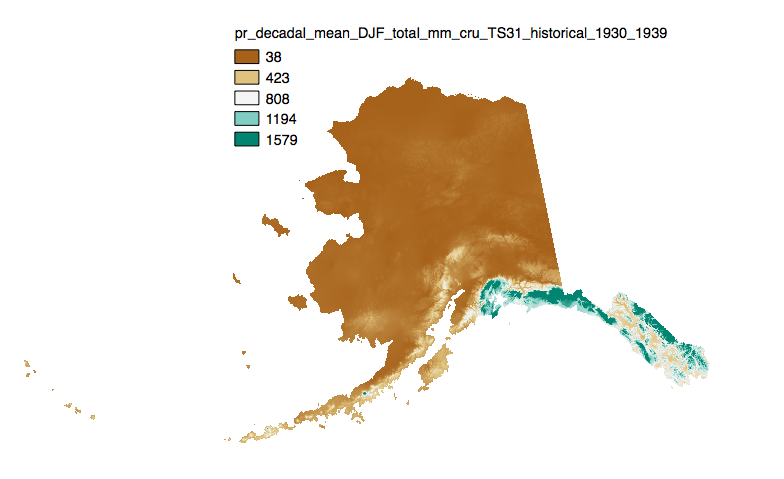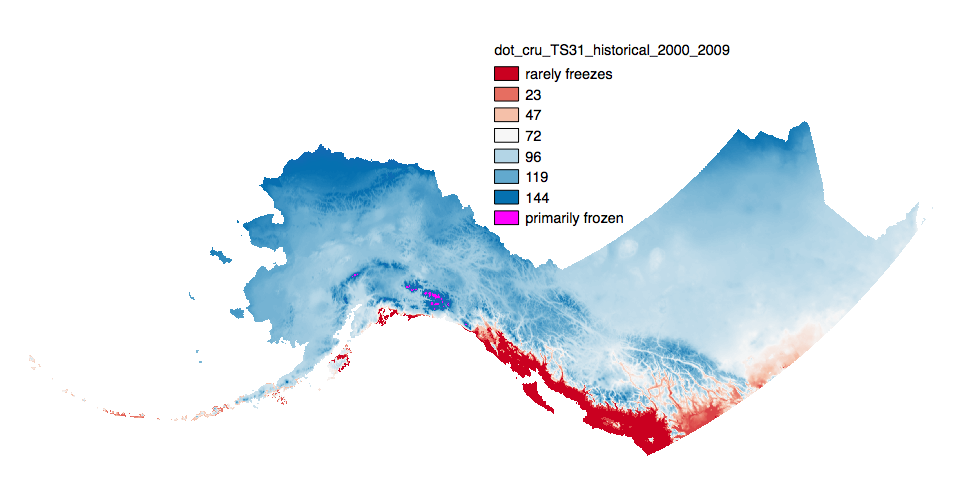asNeeded
Type of resources
Topics
Keywords
Contact for the resource
Provided by
Years
Formats
Representation types
Update frequencies
status
Scale
Resolution
-
This dataset consists of spatial representations of vegetation types produced through summarization of ALFRESCO model outputs. These specific outputs are from the Integrated Ecosystem Model (IEM) project, AR5/CMIP5 climate inputs (IEM Generation 2). ALFRESCO outputs were summarized over three future eras (2010-2039, 2040-269, 2070-2099) and a historical era (1950-2008). Both the proportions of all possible vegetation types and the modal vegetation type (most common type over a given era) are available as sub-datasets. Each are summarized over two future emissions scenarios for five CMIP5 models.
-

This set of files includes downscaled historical estimates of monthly totals, and derived annual, seasonal, and decadal means of monthly total precipitation (in millimeters, no unit conversion necessary) from 1901 - 2006 (CRU TS 3.0) or 2009 (CRU TS 3.1) at 771 x 771 meter spatial resolution.
-

This set of files includes downscaled historical estimates of decadal means of annual day of freeze or thaw (ordinal day of the year), and length of growing season (numbers of days, 0-365) for each decade from 1910 - 2006 (CRU TS 3.0) or 2009 (CRU TS 3.1) at 2x2 kilometer spatial resolution. Each file represents a decadal mean of an annual mean calculated from mean monthly data. **Day of freeze or thaw units are ordinal day 15-350 with the below special cases.** *Day of Freeze (DOF)* `0` = Primarily Frozen `365` = Rarely Freezes *Day of Thaw (DOT)* `0` = Rarely Freezes `365` = Primarily Frozen *Length of Growing Season (LOGS)* is simply the number of days between the DOT and DOF. ---- The spatial extent includes Alaska, the Yukon Territories, British Columbia, Alberta, Saskatchewan, and Manitoba. Each set of files originates from the Climatic Research Unit (CRU, http://www.cru.uea.ac.uk/) TS 3.0 or 3.1 dataset. TS 3.0 extends through December 2006 while 3.1 extends to December 2009. **Day of Freeze, Day of Thaw, Length of Growing Season calculations:** Estimated ordinal days of freeze and thaw are calculated by assuming a linear change in temperature between consecutive months. Mean monthly temperatures are used to represent daily temperature on the 15th day of each month. When consecutive monthly midpoints have opposite sign temperatures, the day of transition (freeze or thaw) is the day between them on which temperature crosses zero degrees C. The length of growing season refers to the number of days between the days of thaw and freeze. This amounts to connecting temperature values (y-axis) for each month (x-axis) by line segments and solving for the x-intercepts. Calculating a day of freeze or thaw is simple. However, transitions may occur several times in a year, or not at all. The choice of transition points to use as the thaw and freeze dates which best represent realistic bounds on a growing season is more complex. Rather than iteratively looping over months one at a time, searching from January forward to determine thaw day and from December backward to determine freeze day, stopping as soon as a sign change between two months is identified, the algorithm looks at a snapshot of the signs of all twelve mean monthly temperatures at once, which enables identification of multiple discrete periods of positive and negative temperatures. As a result more realistic days of freeze and thaw and length of growing season can be calculated when there are idiosyncrasies in the data.
-
This dataset consists of observed and modeled wind data at an hourly temporal resolution for 67 communities in Alaska. Hourly ASOS/AWOS wind data (speed and direction) available via the Iowa Environmental Mesonet AK ASOS network were accessed and assessed for completeness, and 67 of those stations were determined to be sufficiently complete for climatological analysis. Those data were cleaned to produce regular hourly data, and adjusted via a combination of changepoint analysis and quantile mapping to correct for potential changes in sensor location and height. Historical (ERA-Interim reanalysis) and projected (GFDL-CM3 and NCAR-CCSM4) outputs from a dynamical downscaling effort were extracted at pixels intersecting the chosen communities and were bias-corrected using the cleaned station data. This bias-corrected historical and projected data along with cleaned station data make up the entirety of this dataset as a collection of CSV files, for each combination of community and origin (station or model name).
-

This data includes quantile-mapped historical and projected model runs of AR5 daily mean near surface wind velocity (m/s) for each day of every year from 1958 - 2100 at 2.5 x 2.5 degree spatial resolution across 3 AR5 models. They are 365 multi-band geotiff files, one file per year, each band representing one day of the year, with no leap years.
-

This dataset contains climate "indicators" (also referred to as climate indices or metrics) computed over one historical period (1980-2009) using the NCAR Daymet dataset, and two future periods (2040-2069, 2070-2099) using two statistically downscaled global climate model projections, each run under two plausible greenhouse gas futures (RCP 4.5 and 8.5). The indicators within this dataset include: hd: “Hot day” threshold -- the highest observed daily maximum 2 m air temperature such that there are 5 other observations equal to or greater than this value. cd: “Cold day” threshold -- the lowest observed daily minimum 2 m air temperature such that there are 5 other observations equal to or less than this value. rx1day: Maximum 1-day precipitation su: "Summer Days" –- Annual number of days with maximum 2 m air temperature above 25 C dw: "Deep Winter days" –- Annual number of days with minimum 2 m air temperature below -30 C wsdi: Warm Spell Duration Index -- Annual count of occurrences of at least 5 consecutive days with daily mean 2 m air temperature above 90th percentile of historical values for the date cdsi: Cold Spell Duration Index -- Same as WDSI, but for daily mean 2 m air temperature below 10th percentile rx5day: Maximum 5-day precipitation r10mm: Number of days with precipitation > 10 mm cwd: Consecutive wet days –- number of the most consecutive days with precipitation > 1 mm cdd: Consecutive dry days –- number of the most consecutive days with precipitation < 1 mm
-

This set of files includes downscaled projections of monthly means, and derived annual, seasonal, and decadal means of monthly mean temperatures (in degrees Celsius, no unit conversion necessary) from Jan 2006 - Dec 2100 at 771x771 meter spatial resolution. For seasonal means, the four seasons are referred to by the first letter of 3 months making up that season: * `JJA`: summer (June, July, August) * `SON`: fall (September, October, November) * `DJF`: winter (December, January, February) * `MAM`: spring (March, April, May) The downscaling process utilizes PRISM climatological datasets from 1971-2000. Each set of files originates from one of five top-ranked global circulation models from the CMIP5/AR5 models and RCPs or is calculated as a 5 Model Average.
-

This set of files includes downscaled projections of decadal means of annual day of freeze or thaw (ordinal day of the year), and length of growing season (numbers of days, 0-365) for each decade from 2010 - 2100 at 771x771 meter spatial resolution. Each file represents a decadal mean of an annual mean calculated from mean monthly data. ---- The spatial extent includes Alaska. Each set of files originates from one of five top ranked global circulation models from the CMIP5/AR5 models and RPCs, or is calculated as a 5 Model Average. Day of Freeze, Day of Thaw, Length of Growing Season calculations: Estimated ordinal days of freeze and thaw are calculated by assuming a linear change in temperature between consecutive months. Mean monthly temperatures are used to represent daily temperature on the 15th day of each month. When consecutive monthly midpoints have opposite sign temperatures, the day of transition (freeze or thaw) is the day between them on which temperature crosses zero degrees C. The length of growing season refers to the number of days between the days of thaw and freeze. This amounts to connecting temperature values (y-axis) for each month (x-axis) by line segments and solving for the x-intercepts. Calculating a day of freeze or thaw is simple. However, transitions may occur several times in a year, or not at all. The choice of transition points to use as the thaw and freeze dates which best represent realistic bounds on a growing season is more complex. Rather than iteratively looping over months one at a time, searching from January forward to determine thaw day and from December backward to determine freeze day, stopping as soon as a sign change between two months is identified, the algorithm looks at a snapshot of the signs of all twelve mean monthly temperatures at once, which enables identification of multiple discrete periods of positive and negative temperatures. As a result more realistic days of freeze and thaw and length of growing season can be calculated when there are idiosyncrasies in the data.
-

These data contain historical and future projections of percent land cover from 1950 to 2100, as simulated by the Alaska Thermokarst Model for the boreal region. The data are 1km spatial resolution. The climate data used to drive the model simulations are from the Climate Research Unit, Time Series 4.0 (CRU_TS40) for the historical period (1950 to 2015), and from RCP 8.5 and global circulation models NCAR-CCSM4 and MRI-CGCM3 for the projected period (2016 to 2100). Datasets from the years 1950, 2000, 2050, and 2100 are provided. Annual maps are available upon request. Please note that this data is used to fill in a gap in available data for the Integrated Ecosystem Model (IEM) and does not constitute a complete or precise measurement of this variable in all locations. If used for publication, these data should be cited as the following: Genet H., Lara M., McGuire A.D., Jorgenson T.M., Euskirchen E.S., Clein J., Carman T., Rutter R., Rupp S., Breen A., Kurkowski T., Bennett A., Torgenson B., Romanovski V., Marchenko S. 2018. Land cover dynamic in the Tanana Flats from 1950 to 2100 driven by thermokarst activity.
-
This dataset contains historical and projected dynamically downscaled climate data for the State of Alaska and surrounding regions at 20km spatial resolution and hourly temporal resolution. Select variables are also summarized into daily resolutions. This data was produced using the Weather Research and Forecasting (WRF) model (Version 3.5). We downscaled both ERA-Interim historical reanalysis data (1979 - Oct 2015) and both historical and projected runs from 2 GCM’s from the Coupled Model Inter-comparison Project 5 (CMIP5): GFDL-CM3 and NCAR-CCSM4 (historical run: 1970-2005 and RCP 8.5: 2006-2100). This dataset was updated to a version 1.1 in August, 2023 to retain useful fields of latitude and longitude geolocation grids from the WRF model. The original version is available upon request.
 SNAP GeoNetwork
SNAP GeoNetwork